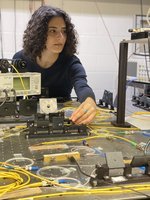Several research groups have risen to the challenge of this arduous task, taking various approaches to achieving phase stability. Unfortunately, these strategies require expensive devices to implement and do not scale easily to a communication network. Researchers at the University of Toronto have opted to use a ring of fiber called a Sagnac interferometer, which offers automatic phase stability and easy networking. In a Sagnac ring, however, the backscattering of light may drown out the signals of interest, making it challenging to extend to long fibers. In a new paper by Reem Mandil et al., published in Physical Review Applied, the University of Toronto researchers devised a simple technique to overcome the backscattering problem and demonstrated that this ring can reach a distance of 200 kilometres—a world-record— while automatically maintaining the phase stability required for a procedure called twin field quantum key distribution (TFQKD). Their results suggest that a Sagnac system is a viable and low-cost approach to metropolitan-scale TFQKD networks, an important step towards the realization of a Quantum Internet.
Reposted from U of T Department of Physics News. Read original post here.

